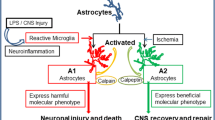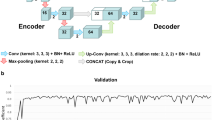Summary
Ultrathin sections of plastic-embedded rat cerebella were incubated with an antiserum against conjugated taurine and subsequently treated with a secondary antibody coupled to colloidal gold. The density of gold particles in various cellular profiles was calculated with the assistance of a computer. In the cerebellar cortex the highest density was found in the somata, dendrites, and dendritic spines of the Purkinje cells, supporting parallel light-microscopical observations in postembedding stained semithin sections from the same tissue blocks. The remaining profiles could be divided into three groups according to their immunolabelling intensity, in descending order: 1) somata and processes of granule and Golgi cells; 2) somata and processes of stellate, basket, and glial cells, and 3) mossy fiber terminals. In a representative experiment, the structures in the first and second groups showed gold particle densities in the range of 19–25%, and 4–11%, respectively, of that in the Purkinje cell somata (values corrected for background) whereas the particle density in the mossy fiber terminals was not significantly above background level. In the cerebellar nuclei, taurine-like immunoreactivity was concentrated in terminals that typically established symmetric or intermediate type contacts with weakly labelled dendrites and cell bodies. These terminals, which shared the ultrastructural features of Purkinje cell terminals, showed an average gold particle density that was about 60% higher than that of the Purkinje somata.
For specificity control, ultrathin sections containing a series of different amino acid conjugates were incubated in the same drops of sera as the tissue sections. The highly selective labelling of the taurine conjugate indicated that the distribution of gold particles in the tissue was not confounded by crossreactivity with GABA, glutamate or other common amino acids but adequately reflected the distribution of fixed taurine. For additional control of specificity, the taurine antiserum was applied to the soluble fraction of a rat brain extract separated by thin layer chromatography. In this system the taurine antiserum stained a single spot that comigrated with free taurine.
The present results suggest that all cell types and processes in the rat cerebellum (with the exception of the mossy fiber terminals) contain taurine. However, the concentration of taurine appears to vary considerably among the different cell types and may also differ between different parts of the same neuron.
Similar content being viewed by others
References
Agrawal HC, Davison AN, Kaczmarek LK (1971) Subcellular distribution of taurine and cysteinesulphinate decarboxylase in developing rat brain. Biochem J 122:759–763
Campistron G, Geffard M, Buijs RM (1986) Immunological approach to the detection of taurine and immunocytochemical results. J Neurochem 46:862–868
Cavallini D, Scandutra R, Dupré S, Santoro L, Barra D (1976) A new pathway of taurine biosynthesis. Physiol Chem Physics 8:157–160
Chan-Palay V (1977) Cerebellar dentate nucleus. Organization, cytology and transmitters. Springer, Berlin Heidelberg New York
Chan-Palay V, Palay SL, Wu J-Y (1982a) Sagittal cerebellar microbands of taurine neurons: Immunocytochemical demonstration by using antibodies against the taurine-synthesizing enzyme cysteine sulfinic acid decarboxylase. Proc Natl Acad Sci 79:4221–4225
Chan-Palay V, Lin C-T, Palay S, Yamamoto M, Wu J-Y (1982b) Taurine in the mammalian cerebellum: Demonstration by autoradiography with [3H]taurine and immunocytochemistry with antibodies against the taurine-synthesizing enzyme, cysteinesulfinic acid decarboxylase. Proc Natl Acad Sci 79:2695–2699
Collins GGS (1972) GABA-2-oxoglutarate transaminase, glutamate decarboxylase and the half-life of GABA in different areas of rat brain. Biochem Pharmacol 21:2849–2858
Collins GGS (1974) The rates of synthesis, uptake and disappearance of [14C]taurine in eight areas of the rat central nervous system. Brain Res 76:447–459
Collins GGS (1977) On the role of taurine in the mammalian central nervous system. In: Youdim MBH, Lowenberg W, Sharman DF, Lagnodo JR (eds) Essays in neurochemistry and neuropharmacology, vol 1. John Wiley, New York, pp 43–72
Frederickson RCA, Neuss M, Morzorati SL, McBride WJ (1978) A comparison of the inhibitory effects of taurine and GABA on identified Purkinje cells and other neurons in the cerebellar cortex of the rat. Brain Res 145:117–126
Hardy PM, Nicholls AC, Rydon HN (1976) The nature of the cross-linking of proteins by glutaraldehyde. I. Interaction of glutaraldehyde with the amino-groups of 6-aminohexanoic acid and of α-N-acetyl-lysine. J Chem Soc Perkin Trans I:958–962
Hökfelt T, Ljungdahl Å (1970) Cellular localization of labeled gamma-aminobutyric acid (3H-GABA) in rat cerebellar cortex: an autoradiographic study. Brain Res 22:391–396
Huxtable RJ (1981) Sources and turnover rates of taurine in nursing and weaned rat pups. J Nutr 111:1275–1286
Kontro P, Marnela K-M, Oja SS (1980) Free amino acids in the synaptosome and synaptic vesicle fractions of different bovine brain areas. Brain Res 184:129–141
Kuriyama K, Ida S, Nishimura C, Ohkuma S (1983) Distribution and function of taurine in nervous tissues: an introductory review. In: Sulfur amino acids: biochemical and clinical aspects. Alan R Liss, New York, pp 127–140
Kuriyama K, Ida S, Ohkuma S (1984) Alteration of cerebral taurine biosynthesis in spontaneously hypertensive rats. J Neurochem 42:1600–1606
Larsson L-I (1983) Methods for immunocytochemistry of neurohormonal peptides. In: Björklund A, Hökfelt T (eds) Handbook of chemical neuroanatomy, vol 1, Elsevier, Amsterdam, pp 147–209
Lin C-T, Li H-Z, Wu J-Y (1983) Immunocytochemical localization of L-glutamate decarboxylase, gamma-aminobutyric acid transaminase, cysteine sulfinic acid decarboxylase, aspartate aminotransferase and somatostatin in rat retina. Brain Res 270:273–283
Lin C-T, Song G-X, Wu J-Y (1985) Ultrastructural demonstration of L-glutamate decarboxylase and cysteinesulfinic acid decarboxylase in rat retina by immunocytochemistry. Brain Res 331:71–80
Madsen S, Ottersen OP, Storm-Mathisen J (1985) Immunocytochemical visualization of taurine: neuronal localization in the rat cerebellum. Neurosci Lett 60:255–260
Marnela K-M, Morris HR, Panico M, Timonen M, Lähdesmäki P (1985) Glutamyl-taurine is the predominant synaptic taurine peptide. J Neurochem 44:752–754
McBride WJ, Frederickson RCA (1980) Taurine as a possible inhibitory transmitter in the cerebellum. Federation Proc 39:2701–2705
McBride WJ, Nadi NS, Altman J, Aprison MH (1976) Effects of selective doses of X-irradiation on the levels of several amino acids in the cerebellum of the rat. Neurochem Res 1:141–152
Meldrum BS, Swan JH, Ottersen OP, Storm-Mathisen J (1987) Redistribution of transmitter amino acids in rat hippocampus and cerebellum during seizures induced by L-allylglycine and bicuculline: an immunocytochemical study with antisera against conjugated GABA, glutamate and aspartate. Neuroscience 22:17–27
Muganini E, Oertel WH (1985) An atlas of the distribution of GABAergic neurons and terminals in the rat CNS as revealed by GAd immunohistochemistry. In: Björklund A, Hökfelt T (eds) Handbook of chemical neuroanatomy, vol 4. Elsevier, Amsterdam, pp 436–608
Okamoto K, Kimura H, Sakai Y (1983a) Evidence for taurine as an inhibitory neurotransmitter in cerebellar stellate interneurons: selective antagonism by TAG (6-aminomethyl-3-methyl-4H,1,2,4-benzothiadiazine-1,1-dioxide). Brain Res 265:163–168
Okamoto K, Kimura H, Sakai Y (1983b) Antagonistic action of 6-aminomethyl-3-methyl-4H,1,2,4-benzothiadiazine-1,1-dioxide (TAG) and evidence for a transmitter role of taurine in stellate interneurons in the cerebellum. In: Sulfur amino acids: biochemical and clinical aspects. Alan R Liss, New York, pp 151–160
Okamoto K, Kimura H, Sakai Y (1983c) Taurine-induced increase of the Cl-conductance of cerebellar Purkinje cell dendrites in vitro. Brain Res 259:319–323
Okamoto K, Kimura H, Sakai Y (1983d) Ionic mechanisms of the action of taurine on cerebellar Purkinje cell dendrites in vitro: Intradendritic study. Brain Res 260:261–269
Ottersen OP (1987a) Postembedding light-and electron microscopic immunocytochemistry of amino acids: description of a new model system allowing identical conditions for specificity testing and tissue processing. Exp Brain Res 69:167–174
Ottersen OP (1987b) Postembedding immunogold labelling permits a semiquantitative assessment of taurine contents in different cell types and processes in rat cerebellum. Soc Neurosci Abstr 13:1289
Ottersen OP, Storm-Mathisen J (1984) Glutamate-and GABA-containing neurons in the mouse and rat brain, as demonstrated with a new immunocytochemical technique. J Comp Neurol 229:374–392
Ottersen OP, Madsen S, Meldrum BS, Storm-Mathisen J (1985) Taurine in the hippocampal formation of the Senegalese baboon Papio papio: an immunocytochemical study with an antiserum against conjugated taurine. Exp Brain Res 59:457–462
Ottersen OP, Storm-Mathisen J, Madsen S, Skumlien S, Strømhaug J (1986) Evaluation of the immunocytochemical method for amino acids. Med Biol 64:147–158
Ottersen OP, Davanger S, Storm-Mathisen J (1987) Glycine-like immunoreactivity in the cerebellum of rat and Senegalese baboon, Papio papio: a comparison with the distribution of GABA-like immunoreactivity and with [3H]glycine and [3H]GABA uptake. Exp Brain Res 66:211–221
Ottersen OP, Madsen S, Storm-Mathisen J, Somogyi P, Scopsi L, Larsson L-I (1988) Immunocytochemical evidence suggests that taurine is colocalized with GABA in the Purkinje cell terminals, but that the stellate cell terminals predominantly contain GABA. A light and electron microscopic study of the rat cerebellum. Exp Brain Res, in press
Palay SL, Chan-Palay V (1974) Cerebellar cortex, cytology and Organization, Springer, Berlin Heidelberg New York
Perry TL, Kish SJ, Hansen S (1979) γ-vinyl GABA: Effects of chronic administration on the metabolism of GABA and other amino compounds in rat brain. J Neurochem 32:1641–1645
Schmidt SY, Berson EL, Hayes KC (1976) Retinal degeneration in cats fed casein. I. Taurine deficiency. Invest Ophthalmol 15:45–52
Somogyi P, Hodgson AJ (1985) Antiserum to γ-aminobutyric acid. III. Demonstration of GABA in Golgi-impregnated neurons and in conventional electron microscopic sections of cat striate cortex. J Histochem Cytochem 33:249–257
Somogyi P, Hodgson AJ, Smith AD, Nunzi MG, Gorio A, Wu J-Y (1984) Different populations of GABAergic neurons in the visual cortex and hippocampus of cat contain somatostatinor cholecystokinin-immunoreactive material. J Neurosci 4:2590–2603
Somogyi P, Halasy K, Somogyi J, Storm-Mathisen J, Ottersen OP (1986) Quantification of immunogold labelling reveals enrichment of glutamate in mossy and parallel fibre terminals in cat cerebellum. Neuroscience 19:1045–1050
Storm-Mathisen J, Ottersen OP (1986) Antibodies against amino acid transmitters, In: Panula P, Päivärinta H, Soinila S (eds) Neurohistochemistry: Modern methods and applications. Alan R Liss, New York, pp 107–136
Storm-Mathisen J, Leknes AK, Bore AT, Vaaland JL, Edminson P, Haug F-MŠ, Ottersen OP (1983) First visualization of glutamate and GABA in neurones by immunocytochemistry. Nature (Lond) 301:517–520
Storm-Mathisen J, Ottersen OP, Fu-long T, Gundersen V, Laake JH, Nordbø G (1986) Metabolism and transport of amino acids studied by immunocytochemistry. Med Biol 64:127–132
Sturman JA, Wen GY, Wisniewski HM, Neuringer MD (1984) Retinal degeneration in primates raised on a synthetic human infant formula. Int Devl Neurosci 2:121–129
Sturman JA, Moretz RC, French JH, Wisniewski HM (1985) Taurine deficiency in the developing cat: persistence of the cerebellar external granule cell layer. J Neurosci Res 13:405–416
Taber KH, Lin C-T, Liu J-W, Thalmann RH, Wu J-Y (1986) Taurine in hippocampus: Localization and postsynaptic action. Brain Res 386:113–121
van Gelder NM, Sherwin AL, Rasmussen T (1972) Amino acid content of epileptogenic human brain: focal versus surrounding regions. Brain Res 40:385–393
Walberg F, Holländer H, Grofová I (1976) An autoradiographic identification of Purkinje axon terminals in the cat. J Neurocyt 5:157–169
Wassef M, Simons J, Tappaz ML, Sotelo C (1986) Non-Purkinje cell GABAergic innervation of the deep cerebellar nuclei: A quantitative immunocytochemical study in C57BL and in Purkinje cell degeneration mutant mice. Brain Res 399:125–135
Wright CE, Tallan HH, Lin YY (1986) Taurine: Biological update. Ann Rev Biochem 55:427–453
Wu J-Y (1982) Purification and characterization of cysteic/cysteine sulfinic acids decarboxylase and L-glutamate decarboxylase in bovine brain. Proc Nat Acad Sci USA 79:4270–4274
Wu J-Y (1983) Preparation of glutamic acid decarboxylase as immunogen for immunocytochemistry. In: Neuroimmunocytochemistry (IBRO Handbook Series: Methods in the Neurosciences). John Wiley and Sons, Sussex, pp 159–191
Yarbrough GG, Singh DK, Taylor DA (1981) Neuropharmacological characterization of a taurine antagonist. J Pharmacol Exp Therap 219:604–613
Yoshida M, Karasawa N, Ito M, Sakai M, Nagatsu I (1986) Demonstration of taurine-like immunoreactive structures in the rat brain. Neurosci Res 3:356–363
Author information
Authors and Affiliations
Rights and permissions
About this article
Cite this article
Ottersen, O.P. Quantitative assessment of taurine-like immunoreactivity in different cell types and processes in rat cerebellum: an electronmicroscopic study based on a postembedding immunogold labelling procedure. Anat Embryol 178, 407–421 (1988). https://doi.org/10.1007/BF00306047
Accepted:
Issue Date:
DOI: https://doi.org/10.1007/BF00306047




